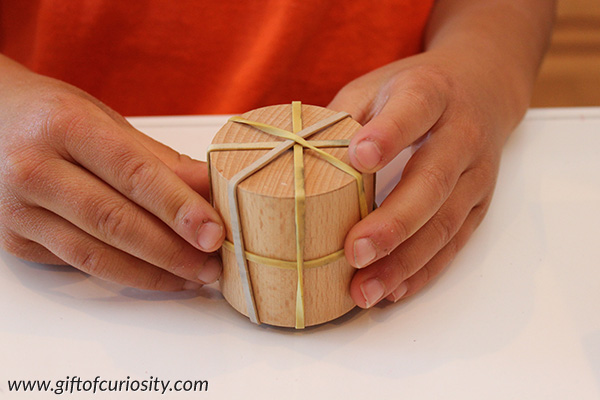Various 3-D objects (e.g., cubes, cylinders, spheres, cones)
Rubber bands
Basic Symmetry Activity Pack for 2-D symmetry activities (optional)
Tinker trays or containers to organize rubber bands
Introduction:
Explain the concept of symmetry and how it applies to both 2-D and 3-D objects.
Show examples of symmetrical 3-D objects and discuss their lines of symmetry.
Setting Up:
Provide a variety of 3-D objects for the activity, such as cubes, cylinders, and other geometric shapes.
Place tinker trays filled with rubber bands nearby for easy access.
Identifying Lines of Symmetry:
Hand the child a cube and some rubber bands.
Ask the child to use a rubber band to indicate one line of symmetry on the cube.
Once the child finds the first line, challenge them to find additional lines of symmetry, including diagonal lines.
Exploring Different Objects:
Hand the child a cylinder and ask them to mark the lines of symmetry with rubber bands.
Discuss the infinite number of lines of symmetry around the circumference of the cylinder and the vertical lines of symmetry.
Hands-On Practice:
Allow the child to explore finding lines of symmetry in various 3-D objects, marking them with rubber bands.
Encourage independent exploration and problem-solving.
Support and Guidance:
Provide support for children who may struggle with the concept of symmetry or spatial awareness.
Use verbal prompts and physical demonstrations to help them understand and complete the task.
Reflection and Discussion:
Ask the child to share their findings and describe the process of identifying lines of symmetry in different objects.
Discuss how symmetry affects the appearance and structure of 3-D objects.
Additional Challenge:
Introduce more complex 3-D shapes, such as pyramids or irregular objects, and challenge the child to find and mark the lines of symmetry.
Difficulty Levels:
Kindergarten: Focus on simple 3-D objects like cubes and cylinders. Provide more guidance and support.
Grade 1: Introduce more complex shapes and encourage independent exploration.
Grade 2: Challenge children to find and mark lines of symmetry in a variety of 3-D objects, including irregular shapes.
What Happened?
Children identified and marked lines of symmetry in various 3-D objects using rubber bands.
They practiced fine motor skills, spatial awareness, and problem-solving by exploring the concept of symmetry.
The activity provided a hands-on and engaging way to understand and apply symmetry in a 3-D context.
Explore More:
Use the Basic Symmetry Activity Pack to explore 2-D symmetry activities.
Discuss and explore symmetry in nature by finding symmetrical objects outdoors.
Incorporate symmetry into other subjects, such as creating symmetrical structures in building activities.
Extension Activities:
Explore asymmetry by identifying objects without lines of symmetry and discussing the differences.
Create symmetrical 3-D models using building blocks or clay, emphasizing the lines of symmetry.
Use mirrors to explore reflective symmetry with 3-D objects, observing how reflections create symmetrical patterns.

